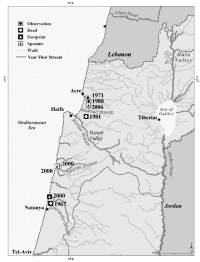 |
Last Update:
Thursday November 22, 2018
|
| [Home] |
|
Volume 23 Issue 1 Pages 1 - 48 (April 2006) Citation: Guter, A., Dolev, A., Saltz, D. & Kronfeld-Schor, N. (2006) Do Otters Occasionally Visit Israel’s Coastal Plain? IUCN Otter Spec. Group Bull. 23 (1): 12 - 14 Do Otters Occasionally Visit Israel’s Coastal Plain? Amichai Guter1, Amit Dolev1,2, David Saltz2 and Noga Kronfeld-Schor3 1 Israel Mammal Centre, Society for the Protection of Nature in Israel, Tel-Aviv, 66183, Israel (accepted 31st October 2006)
Up until the middle of the 20th century, Eurasian otters (Lutra lutra) were abundant in Israel in all coastal rivers extending from the Lebanese border to the Tel-Aviv region, as well as along the Jordan River from its source to the Dead Sea. Only these two water systems, the Jordan River basin in the East and the coastal plain in the West, can support otters. A connecting corridor between these regions exists in the Harod valley and the Yizrael Valley. However, during the 1960s the otter population underwent a dramatic decline due to illegal hunting, water pollution, and the drainage of water sources (MENDELSSOHN and YOM-TOV, 1999), and the coastal plain population was considered extinct (SHALMON, 1994). An initial field survey for signs of the Eurasian otter, in accordance with the 'Standard Method', was carried out in 2000 (REUTHER and DOLEV, 2000). Since then, we have been conducting annual surveys at 94 permanent sprainting sites along the Jordan River basin and the coastal plain (DOLEV et al., 2006). Whilst otter signs (spraints, footprints) were found regularly along the Jordan valley, and the percentage of positive sites there is relatively constant, otter signs were very rare in the western region. In fact, signs were found along the Mediterranean shore only three times: in March 1986, spraints were found in a small river in the northern coastal plain near Akko (Acre) (MACDONALD et al., 1986); in October 2000, spraints and footprints were found in two streams in the central coastal plain (REUTHER and DOLEV, 2000); and finally in a recent survey carried out in March 2006, spraints were found again in a river outlet near Akko (Figure 1). Direct observations of otters along the coastal plain are even more unusual: the last records of sightings of individuals along the coastal plain were in 1967 (south to Haifa) and in 1988 (along the northern coastal plain) (GUTER, 2004). Two recent but unconfirmed observations of otters from the central coastal plain are dated to November 2000. Since field surveys have been carried out using the same method by the same surveyors for the last six years, we believe that the sporadic records of spraints found in 2000, and then later in 2006, in the coastal plain cannot indicate a stable population. It seems more likely that these signs belong to migrant otters coming from the Mediterranean Sea, presumably from the Lebanese coast (40 to 80 km away). These visits are uncommon but may indicate a pattern repeated once in a few years. The Israel otter population forms the south-eastern border of the Mediterranean-Arab range of this species. It is unclear whether the Israeli otter population is connected to its counterparts in Syria and in Lebanon and whether they still exist there at all. Therefore, the otter population in Israel might be isolated. Hence, this phenomenon is of great importance to the Israeli otter population as it may be one of the few sources of genetic variability. ACKNOWLEDGMENTS - We thank Yossi Ben-Ari and Ashael Raveh for their assistance in the field-work and Ayelet Sapir and Guy Nizri (GIS division, SPNI) for preparing the map. The field survey was supported by the Nature and Parks Authority. REFERENCES Dolev, A., Guter, A., Saltz, D. & Kronfeld-Schor, N. (2006). Israel’s otter (Lutra lutra) population, status and future conservation. The Return of the Otter in Europe – Where and How? Sabhal Mor Ostaig, Isle of Skye, 30 June – 5 July 2003. (Edited by Conroy, J.W.H., Yoxon, G., Gutleb, A.C. & Ruiz-Olmo, J.). International Otter Survival Fund, Broadford, Isle of Skye. |
| [Copyright © 2006 - 2050 IUCN/SSC OSG] | [Home] | [Contact Us] |
 IUCN/SCC Otter Specialist Group Bulletin
IUCN/SCC Otter Specialist Group Bulletin